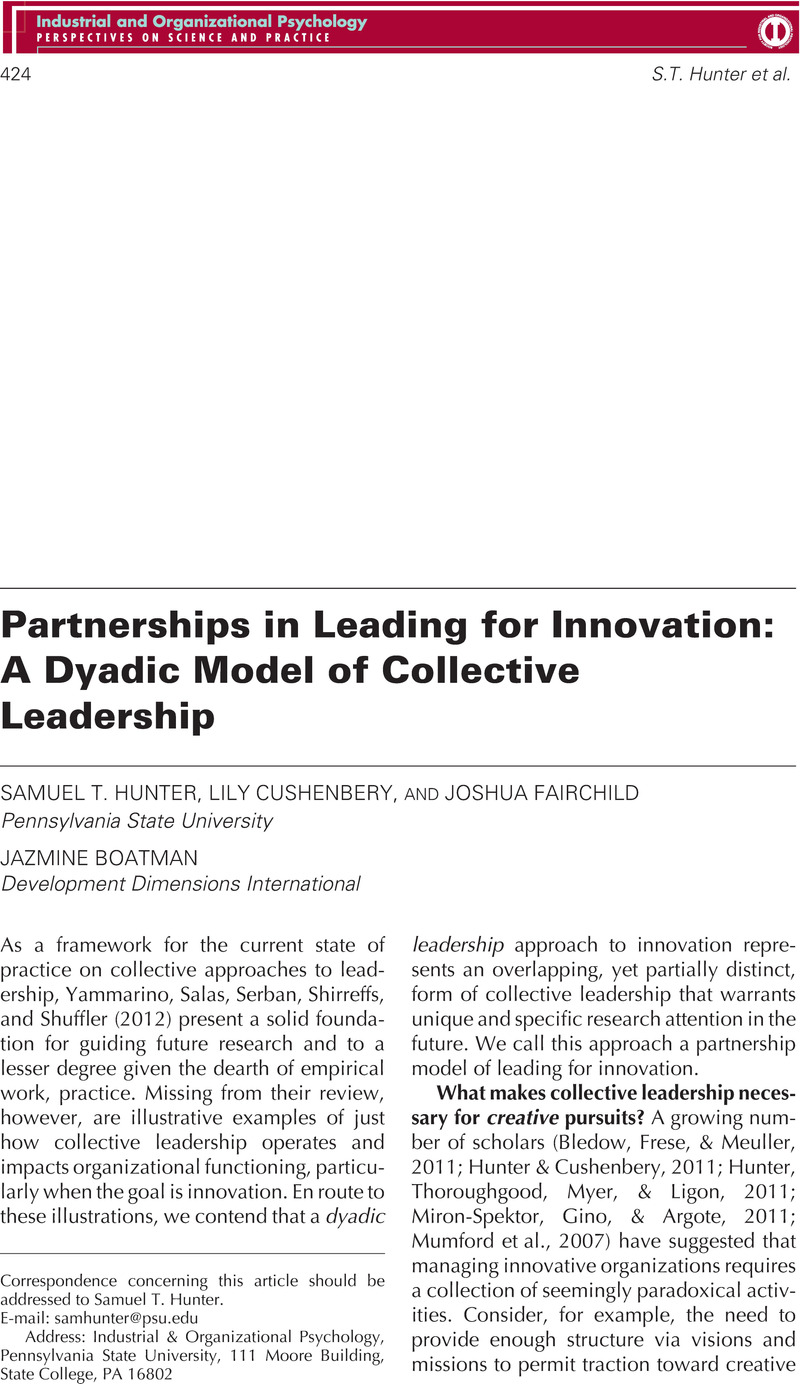Crossref Citations
This article has been cited by the following publications. This list is generated based on data provided by Crossref.
Shuffler, Marissa L.
Salas, Eduardo
Yammarino, Francis J.
Serban, Andra
and
Shirreffs, Kristie
2012.
Putting the “We” in Leadership: Continuing the Dialogue to Advance Our Science and Practice.
Industrial and Organizational Psychology,
Vol. 5,
Issue. 4,
p.
437.
Kriger, Mark
and
Zhovtobryukh, Yuriy
2013.
Rethinking strategic leadership: stars, clans, teams and networks.
Journal of Strategy and Management,
Vol. 6,
Issue. 4,
p.
411.
Mainemelis, Charalampos
Kark, Ronit
and
Epitropaki, Olga
2015.
Creative Leadership: A Multi-Context Conceptualization.
Academy of Management Annals,
Vol. 9,
Issue. 1,
p.
393.
Mainemelis, Charalampos
Kark, Ronit
and
Epitropaki, Olga
2015.
Creative Leadership: A Multi-Context Conceptualization.
Academy of Management Annals,
Vol. 9,
Issue. 1,
p.
393.
Bintz, Carol
2016.
Visual literacy: does it enhance leadership abilities required for the twenty-first century?.
Journal of Visual Literacy,
Vol. 35,
Issue. 2,
p.
91.
Dust, Scott B.
and
Ziegert, Jonathan C.
2016.
Multi‐Leader Teams in Review: A Contingent‐Configuration Perspective of Effectiveness.
International Journal of Management Reviews,
Vol. 18,
Issue. 4,
p.
518.
Friedrich, Tamara L.
Griffith, Jennifer A.
and
Mumford, Michael D.
2016.
Collective leadership behaviors: Evaluating the leader, team network, and problem situation characteristics that influence their use.
The Leadership Quarterly,
Vol. 27,
Issue. 2,
p.
312.
Clausen, Christina
Lavoie‐Tremblay, Melanie
Purden, Margaret
Lamothe, Lise
Ezer, Héléne
and
McVey, Lynne
2017.
Intentional partnering: a grounded theory study on developing effective partnerships among nurse and physician managers as they co‐lead in an evolving healthcare system.
Journal of Advanced Nursing,
Vol. 73,
Issue. 9,
p.
2156.
Clausen, Christina
Cummins, Kelly
and
Dionne, Kelley
2017.
Educational interventions to enhance competencies for interprofessional collaboration among nurse and physician managers: An integrative review.
Journal of Interprofessional Care,
Vol. 31,
Issue. 6,
p.
685.
DeSisto, Marco
Cavanagh, Jillian
and
Bartram, Timothy
2019.
Bushfire investigations in Australia.
Leadership & Organization Development Journal,
Vol. 41,
Issue. 2,
p.
177.
BELLIS, PAOLA
and
VERGANTI, ROBERTO
2020.
PAIRS IN INNOVATION: HOW WORKING IN PAIRS HELPS ORGANISATIONS TO MOVE INTO A NEW SHARED DIRECTION.
International Journal of Innovation Management,
Vol. 24,
Issue. 03,
p.
2050072.
Rouse, Elizabeth D.
2020.
Where You End and I Begin: Understanding Intimate Co-creation.
Academy of Management Review,
Vol. 45,
Issue. 1,
p.
181.
Bellis, Paola
and
Verganti, Roberto
2021.
Pairs as pivots of innovation: how collaborative sensemaking benefits from innovating in twos.
Innovation,
Vol. 23,
Issue. 3,
p.
375.
Bellis, Paola
Verganti, Roberto
and
Trabucchi, Daniel
2022.
Let's move on! How pair collaboration activates resilience toward innovation crises.
European Management Journal,
Bellis, Paola
Buganza, Tommaso
and
Verganti, Roberto
2023.
What kind of intimacy is meaningful to you? How intimate interactions foster individuals' sensemaking of innovation.
Creativity and Innovation Management,
Vol. 32,
Issue. 3,
p.
407.
Watts, Logan L.
Nandi, Sampoorna
and
Linhardt, Rylee M.
2023.
Handbook of Organizational Creativity.
p.
89.





